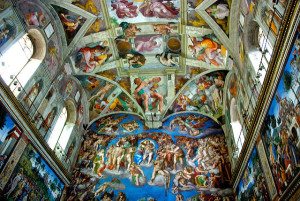
Fortunately for Michelangelo, and many other great Renaissance artists, the church and rich merchants were able to pay so much money to famous artists for a single work that the artists did not need to sell multiple copies of their work in order to make a living.
This all changed with the printing press, then with photography, and ultimately the Internet arrived to make the copying and transferring of creative works as fast and easy as clicking a button. Maybe clicking it twice. When copying became this easy, copyright law was developed to serve as a market fix. It could take a painter four years to paint a masterpiece, but it may have taken a week for a skilled forger to make a copy. Copyright law gave artists the ability to control the market for copies of their art, which in turn incentivized artists to continue making that art.
The point of all of this is to say that the idea of “copyright law as a market fix” has, historically and internationally, only told part of the story. Around the world, copyright law has long stood for another proposition: that the artist has a moral right to their works. As the theory goes, when a man or woman’s creative spark and artistic labor creates something new, that something belongs to the artist.
In America, however, there is no blanket, moral rights protection for artists. At least, there wasn’t until 1990, when Congress passed the Visual Artists Rights Act, which grants moral rights for some types of artistic works. VARA, as it is known, covers only “works of visual art,” which includes paintings, sculptures, drawings, prints, and still photographs produced for exhibition. Additionally, no more than 200 copies can be produced of the work if the work and its copies are to receive the protections of VARA.
And those protections are pretty substantial. The most common right invoked under VARA is the right of the artist to prevent destruction or mutilation of their work. This comes up frequently with murals painted in parks and on buildings, including recently in Detroit. VARA also allows artists to remove their name from works that they authored, but were subsequently changed against the artist’s wishes. Believe it or not, this was not a given before VARA.
Of course, there are exceptions to VARA protections. For one, if a building owner makes a good-faith attempt to notify an artist that he or she plans to remove the artist’s work without damaging it, the building owner will be able to remove the work, in most cases. Another exception is that VARA does not protect works created before its enactment date (in December of 1990). Finally, unlike standard copyrights which last for the life of the author plus seventy years, VARA rights die with the artist.
Exceptions aside, VARA is an important protection for particularly susceptible works of art. It opens the door to federal court for artists, and allows up to $20,000 in damages, or even up to $100,000 in damages if the work was copied or destroyed intentionally.
If you believe VARA can apply to your work, or you have any other questions regarding federal copyright protection, registration, or infringement, please give our expert copyright attorneys a call at 855-473-8474.